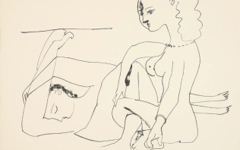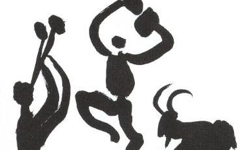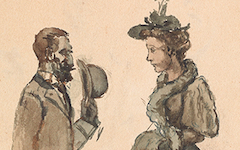Picasso’s La Maison Tellier (1971)
Two of the Gospels recount how when Salome danced for Herod on his birthday, he offered her in return anything she wanted. Salome, after consulting her mother, asked Herod for the head of St. John the Baptist. In Picasso's version the two scenes are combined inconsistently. Salome dances with the Baptist's head already on the charger and at her feet. Why? The easy answer is that great masters, contrary to what literalists believe, do not illustrate other people's stories even when asked to do so. Another is more subtle.
Just as we have shown elsewhere that Donatello identified with the severed head of Goliath at the feet of his executioner, so Picasso has identified with the executed head of John the Baptist at the bottom of this image. Indeed it is through the Baptist's head "looking up at the scene" that the scene itself is supposedly imagined. The saint's head is the poetic artist's.
Click next thumbnail to continue
The evidence is in the almost comical expression of the saint. One eye is open to represent the exterior perception of a painter; the other closed to symbolize the poetic insight of a great master. Both are needed to create art. Yet, however common the expression is in art, its meaning is little known among art historians.
Click next thumbnail to continue
Worth noting is that the dancing Salome is also an aspect of the artist and his androgyne nature. Try to imagine her giant hands as placed on the surface we are looking at. The fingers and thumb of one hand can then be thought of as holding an (invisible) engraver's burin while the other presses down on the metal plate to hold it still. She is a dancing "artist". Dancing is, besides, a well-known means of encouraging mystical insight.
Biblical scenes may look like illustrations of a story, especially when "portrayed" by artists earlier than Picasso. They almost never are.
More Works by Picasso
Don't accept your first understanding of a line. Think again; because artists do before drawing it.

Picasso’s Women on the Beach (1947)
Notes:
1. Though Salome did not literally kill the Baptist, it was she who demanded his death.
Original Publication Date on EPPH: 24 Sep 2010. | Updated: 0. © Simon Abrahams. Articles on this site are the copyright of Simon Abrahams. To use copyrighted material in print or other media for purposes beyond 'fair use', you must obtain permission from the copyright owner. Websites may link to this page without permission (please do) but may not reproduce the material on their own site without crediting Simon Abrahams and EPPH.





